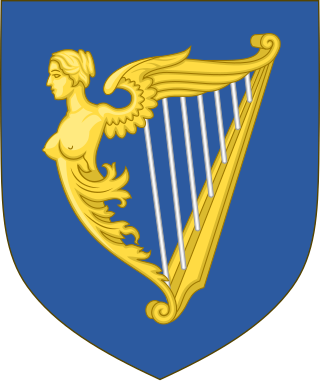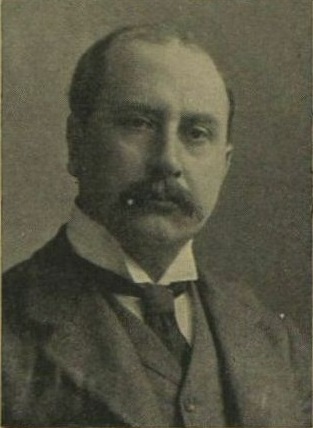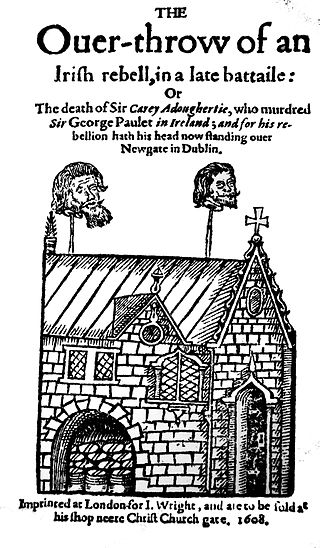
The Irish Parliamentary Party was formed in 1874 by Isaac Butt, the leader of the Nationalist Party, replacing the Home Rule League, as official parliamentary party for Irish nationalist Members of Parliament (MPs) elected to the House of Commons at Westminster within the United Kingdom of Great Britain and Ireland up until 1918. Its central objectives were legislative independence for Ireland and land reform. Its constitutional movement was instrumental in laying the groundwork for Irish self-government through three Irish Home Rule bills.

Hugh Edward Kennedy was an Irish judge, politician and barrister who served as Chief Justice of Ireland from 1924 to 1936, a judge of the Supreme Court from 1924 to 1936 and Attorney General of Ireland from 1922 to 1924. He served as a Teachta Dála (TD) for the Dublin South constituency from 1923 to 1924. As a member of the Irish Free State Constitution Commission, he was also one of the constitutional architects of the Irish Free State.

The Rt. Hon. Standish O'Grady, 1st Viscount Guillamore, PC, from Cahir Guillamore, County Limerick, served as Lord Chief Baron of the Exchequer for Ireland for a number of years. He was created Viscount Guillamore by a patent of 28 January 1831.
Events from the year 1916 in Ireland.
The High Court of Ireland is a court which deals at first instance with the most serious and important civil and criminal cases. When sitting as a criminal court it is called the Central Criminal Court and sits with judge and jury. It also acts as a court of appeal for civil cases in the Circuit Court. It also has the power to determine whether or not a law is constitutional, and of judicial review over acts of the government and other public bodies.
The Dáil Courts were the judicial branch of government of the Irish Republic, which had unilaterally declared independence in 1919. They were formally established by a decree of the First Dáil on 29 June 1920, replacing more limited Arbitration Courts that had been authorised a year earlier. The Dáil Courts were an integral part of the Irish Republic's policy of undermining British rule in Ireland by establishing a monopoly on the legitimate use of force. They continued in operation until shortly into the life of the Irish Free State, which was established on 6 December 1922, after the approval of the Anglo-Irish Treaty.

Hugh Holmes QC was an Irish Conservative Party, then after 1886 a Unionist Member of Parliament (MP) in the United Kingdom Parliament and subsequently a Judge of the High Court and Court of Appeal in Ireland.

Lissadell House is a neo-classical Greek revivalist style country house in County Sligo, Ireland.
Jonathan Ernest Pim PC (1858–1949), was an Irish lawyer and judge, and Liberal politician.
Rickard Deasy PC was an Irish lawyer and judge.
Charles Andrew O'Connor, PC, PC(I),SL, KC was an Irish judge who served as a Judge of the Supreme Court from 1924 to 1925. His judgment in a habeas corpus case of R. (Egan) v. Macready is still influential.

Redmond John Barry was an Irish lawyer and judge who became Lord Chancellor of Ireland; his promising career was cut short by his early death.
Timothy Michael Sullivan was an Irish judge who served as Chief Justice of Ireland from 1936 to 1946, a Judge of the Supreme Court from 1924 to 1946, President of the High Court and a Judge of the High Court from 1924 to 1936.
Henry Wilmot Ormsby PC, QC was an Irish lawyer and judge.
Sir James O'Connor, KC PC (I), was an Irish solicitor, barrister and judge. He was appointed Solicitor-General for Ireland in 1914, Attorney-General for Ireland in 1917, and a judge of the Supreme Court of Judicature of Ireland in 1918. After his enforced retirement in 1924, he practised at the English bar until 1929, when he returned to Ireland and was readmitted to practice as a solicitor, a controversial move necessitating a leading judgment on the standard of professional conduct to be expected of a former judge.

Peter O'Brien, 1st Baron O'Brien, PC, QC, known as Sir Peter O'Brien, Bt, between 1891 and 1900, was an Irish lawyer and judge. He served as Lord Chief Justice of Ireland between 1889 and 1913. In his lifetime he was universally known as Peter the Packer, due to the skill he displayed as Attorney-General in securing verdicts by packed juries.

William Huston Dodd was an Irish politician, barrister and judge. He held the Crown office of Irish Serjeant-at-law, sat in the House of Commons of the United Kingdom as member for North Tyrone, and served as a judge of the High Court of Justice in Ireland from 1907 to 1924. There is a sympathetic account of his personality in the celebrated legal memoir The Old Munster Circuit by Maurice Healy.

Phelim Reagh MacDavitt or Phelim Reagh MacDevitt was a Gaelic Irish warrior and landowner notable for his participation in the Nine Years War and later in O'Doherty's Rebellion in 1608. After playing a leading part in the Burning of Derry, he was captured and executed following the Battle of Kilmacrennan.
The Kenmare Incident, as it came to be known, was an attack in May 1923 by Irish Army officers on two young women in their home in Kenmare, County Kerry, Ireland. Two investigations were undertaken, one by the Garda Síochána and one by a Military Court of Inquiry. The latter recommended court-martial proceedings. After the intervention of the Minister for Defence, Richard Mulcahy and the President of the Executive Council W. T. Cosgrave, the court-martial proceedings ended.
Sir John Elliott (1546-1617) was an Irish judge of the late sixteenth and early seventeenth centuries, who held office as third Baron of the Court of Exchequer (Ireland). He was also occasionally employed on diplomatic missions. Though his highly successful career was due partly to his own merits, it probably also owed something to his useful family connections, notably with the Rochfort family and the Usshers.









